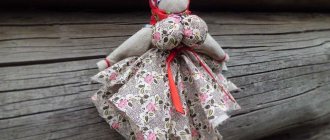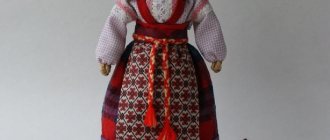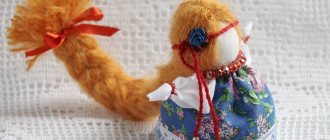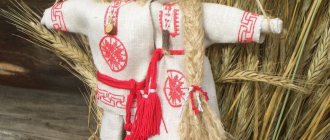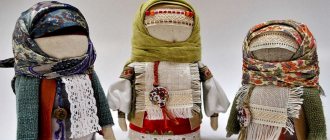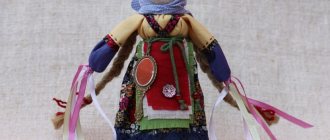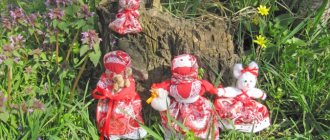Amulet dolls are considered to be a thing of the past. But in fact, these special handmade amulets can still serve us today. During pagan times, they were a mandatory attribute of every Slavic home. Dolls were made for holidays, important events, and other special reasons.
Slavic dolls, or lyalki as they were also called, protected, helped to harvest crops, heal from illnesses, and strengthen the family. Many traditions associated with the manufacture of these amulets and their use have survived to this day. Armed with this knowledge, you can apply it to your own life, changing it for the better.
The history of the appearance of amulets dolls
Slavic doll amulets appeared a very long time ago. Our forefathers believed that the World consists not only of human lands, but also the habitats of light and dark gods. They worshiped the light gods, asked them for protection or fulfillment of desires, fearing the dark ones. They were afraid not only of Chernobog, but also of his minions: strong demons, weaker spirits, people serving him - witches, sorcerers.
Offering prayers and bringing gifts to pagan deities, the Slavs additionally made various protective items. This is how the first doll appeared.
The folk amulet doll served different purposes - it brought wealth to the house, attracted love, helped to conceive a child or protect loved ones from evil forces.
The history of the amulet doll in Rus' began with the simplest materials at hand - tree branches or vines. Gradually, fabric began to be added to them, and over time, some of the dolls were made only from fabric. During pagan times, many people studied herbs. With their help, the Slavs treated, drove out diseases and evil spirits, and extended youth. Therefore, such amulets were often filled with dried herbs, which enhanced its magical properties.
Experienced women who have seen a lot in their lifetime worked on them. Most often these were grandmothers and great-grandmothers, but sometimes the mothers of the family were involved in making amulets. It was strictly forbidden to interfere with them. The needlewoman had to fully concentrate on the process. It was necessary to make the doll at a time, without stretching the process over several stages.
Such amulets were treated with great respect and passed down from mother to daughter.
Types of dolls in Rus'
Some people still perceive dolls as ordinary toys, thinking that they are only good for entertaining a child. Others hold them in high regard, believing that toys help prepare a child to interact with society. And only a minority knows that dolls used to act as magical objects.
All Slavic dolls were divided into three types:
- gaming;
- ritual;
- protective.
Each of these types had its own task and rules of use.
Playing children's dolls
The Slavs made children's play dolls in the form of people, animals and even birds from wood.
Children's ones are considered the easiest to make. Devoid of any magical background, they were designed to entertain and bring joy. The materials chosen were varied, but most often it was wood. These toys were made in the form of people, animals and even birds.
Ritual dolls in Rus'
The Maslenitsa scarecrow is a striking example of a ritual doll among the Slavs.
This subspecies was made exclusively for a specific event. Not only for such important holidays as Maslenitsa or Ivan Kupala, but also for family celebrations. For example, childbirth. This is a painful and dangerous process that takes away the mother’s strength. Unable to protect the child at such an important moment, a woman can shift this task to Kuvadki. For the wedding celebration, the newlyweds also received ritual dolls called Lovebirds as a gift. Such a talisman strengthened love and helped preserve family happiness. Dolls for holidays were usually decorated with special magical symbols - most often Kolovrat.
Slavic protective dolls
A protective doll or a protective doll can be of several types - individual or family. The first was made for a specific family member. Usually for a woman, because she is the one responsible for procreation and therefore must be healthy. The second was made for the whole family. With its help they protected themselves from the envy of neighbors, homewreckers and dark forces.
What are Slavic dolls made of?
Slavic dolls were made from natural bases. It could not be otherwise, because then there were no such artificial materials as there are now. But even if they existed, no one would even think of using them to create talismans.
The Slavs respected and loved nature, and therefore believed that the natural basis would be the best choice for a talisman. She will give him her power. Wood was chosen for body jewelry that protected against all sorts of troubles. But they didn’t make protective dolls from it - only children’s toys.
The Slavs gave preference to natural materials in the manufacture of amulets.
The Russian amulet doll was made by craftswomen in sewing, knitting or embroidery. Therefore, handicraft supplies were most often used for it: fabrics, threads, ribbons, laces, beads, buttons. Sometimes vines or tree branches.
In some cases, a special filler was added - ash, cereals or herbs. They selected it in accordance with the goal they wanted to achieve. The grains were hidden in a doll when they wanted to attract wealth - so that there would always be food on the table. Ash is used to ward off evil spirits, and herbs are used to cleanse energy or prevent diseases.
If you decide to make a talisman with your own hands, do not rush into it. Think carefully about the purposes for which you need it, and then study the rules for its manufacture. This is a serious task that requires a careful approach.
Activation and use of the doll
Conspiracies can be very different and depend on what kind of help the doll’s owner wants to receive from it. Therefore, they took any conspiracy suitable for the occasion, but you can replace it with a request expressed in your own words. In this case, you should think carefully about the text in advance, learn it by heart and pronounce it clearly and without hesitation in front of the doll. After reading the plot, the doll should be placed in a sunny place to replenish the energy of the sun. And if it happens in cloudy weather, then lighted candles are quite suitable.
Having completed these rituals, the doll must be praised and thanked in advance for the help it will provide, and placed in the place intended for it in the house. If the amulet was made for another person, then you need to tell this to the doll so that it knows the owner.
Important! Without special activation, the doll will remain just a funny toy. The Slavs used a combination of the power of natural elements and special spells to charge amulets.
The most famous amulets dolls
The amulet doll was an important element of Slavic culture. They were placed in prominent places in the house, placed in a child's cradle, and sometimes carried with them. Having learned about what kind of Slavic doll amulets there are and what their meaning is, you can make one for yourself and your family, continuing the traditions of your ancestors.
Zolnaya
An ash doll helps protect the house from evil spirits and attracts prosperity to it. The name of the amulet comes from the word “ash”, because it was used as a filler. A handful of ash from the oven was placed in a piece of cloth, from which a ball was then made - this was the head.
A distinctive feature of Zolnaya is the complete absence of hair on her head. They didn’t even make her a headdress. And they passed it on to the next generations instead of burning it.
Herbalist-Kubishka
The Herbal Pot helped clean the air in the house. They placed it in places where energy stagnation was felt. If someone had trouble sleeping, they would leave them near that person overnight. The amulet spread a pleasant herbal aroma, helping to normalize sleep.
The Herbalist was also used to ward off diseases - they hooked it onto a child’s cradle. Unlike Zolnaya, she was filled with special contents not in her head, but in her torso.
Pelenashka
Children are more defenseless against evil than adults. To protect their descendants from darkness, the Slavs made Pelenashki dolls for children. Such amulets were placed directly in the cradle. They diverted illnesses and troubles from the children, taking them for themselves.
Lovebirds
The Lovebirds did not make the doll themselves. But they could be received as a wedding gift. It was given by close relatives - these could be mothers or grandmothers on the part of any of the newlyweds.
Lovebirds are easy to recognize by one striking sign - the hands with which they hold each other are intertwined into one, which symbolizes a strong union. The amulet was made from different materials - straw, fabric or thread.
Desire
The meaning put into the Zhelannitsa doll can be easily guessed by its name. But don’t rush to write down a dozen wishes on a piece of paper. She can only fulfill one request. Therefore, it is better to focus on what is most important.
For the Desire to understand what is required of her, talk to her after creating her. Tell us in detail what you want to receive. This needs to be done in front of a mirror. When the dream turns into reality, burn the amulet, and before destroying it, thank it for the good work.
Purifier
The purifier was used to heal physical diseases and illnesses caused by evil spirits. It never acted as a talisman for the family - it was made specifically for a sick person. He or his close relative must have mentally transferred all the bad things to the object during the creation of the doll.
Upon completion of work on it, they uttered a conspiracy: “Let all the bad things go from me to you, take away the evil, alien things for yourself.” Then all that remained was to burn it away from home and the disease would soon recede.
Ten-handle
According to tradition, the Ten Handle was given to young women who got married.
It's no coincidence that she has ten arms. It was believed that such a talisman would help the young housewife keep up with everything: look after the children, cook, eat, clean. The ten-handle was made only from straw. The doll's head was decorated with a scarf, and her body was decorated with an elegant apron. One of the main colors was red, symbolizing vitality and prosperity.
Doll Day Night
Day Night, like Lovebirds, is difficult to confuse with others. This is a double-sided amulet. You can make it in several ways: take two separate figures and fasten them back to back. Or make one figurine with two front sides.
One side symbolizes day, and the other - night. The main task of such a talisman is to keep track of the usual order of things. Day Night watches the change of day and night, making sure that the night is as calm and favorable for the inhabitants of the house as the day. In the daytime, the daytime appearance was turned to face the residents, and in the dark, the nighttime appearance was turned.
bbw
The fat woman will be a good amulet for every woman who dreams of creating a full-fledged family.
The image of Fat Girl is a girl growing up. Used it to help get pregnant. The Slavs believed that the doll's long braid helped attract the child's soul. If, after a year of married life, a woman could not conceive an heir, her relatives made such a talisman for her. Only female relatives could do it - mother, grandmother or great-grandmother, but not sister.
plantain
The Slavs made amulets not only to protect the home, but also tried to protect relatives located outside of it. This is how they made amulets for travelers.
The plantain protected the person on the way. This was ensured by a special ritual associated with a small bag of the Plantain. A handful of earth from their native lands was placed in it - it was believed that this gave a person strength. In addition to this, grains or bread crumbs were added to the bag - thanks to this, the traveler never went hungry.
Bird Joy
The Slavs believed that spring did not come on its own - it was brought on the wings of birds. In order to quickly summon the flowering season, they made a special ritual doll - the Bird of Joy. She was covered from head to bottom with birds, symbolizing spring, good luck and happiness.
You need to make an odd number of birds, and one of them must be attached to the doll’s head. They also tried to make the headdress, the scarf, in the shape of a bird - with wings on the sides and a beak on top.
Veduchka, or leading to life
The veduchka was made by women who knew the joy of motherhood.
One of the most important women's tasks was considered to be the continuation of the Family. The woman had to not only feed the child, feeding him with her juices, but also raise him. Veduchka helped in this difficult task, supporting the mother and providing contact with the child. Externally, the amulet stood out among the rest - there was not one figurine, but two. Mother with child. The hands of the woman and the baby are united, which signified a strong spiritual connection between them.
Dolls Krupenichka and Man Rich
Krupenichka, also called Zernushka, helped feed the family. Not only figuratively, but also literally. It was made after the harvest, filling a hidden inner bag with grain. When the family had nothing to eat, the women took grains out of it and used it for lunch. They did this not only during periods of famine, but regularly, replacing old grain with new ones.
Krupenichka was considered the main one in the pair, but the Muzhik Bogach accompanying her was also important. He helped financially. In fact, this paired amulet is an image of a happy Slavic family - a skillful housewife and breadwinner of the family.
Baba Yaga
Many people associate Baba Yaga with an evil character, but in fact this is not entirely true. Even in folk tales that have come down to us, the old witch sometimes acts as an assistant, helping heroes out of all sorts of troubles.
Baba Yaga is not only a good adviser - she can become the keeper of the hearth. It was hung on the front door or on the windows of the house. So she swept away all sorts of nasty things - visible and invisible - from the house with her broom.
Pock
One of the most revered trees among the Slavs was the rowan. This influenced the emergence of such a talisman as the Rowan doll. It was made in the fall. The basis for the Rowan was a cross made of real rowan - this made the amulet more powerful.
Such a talisman protected from evil, protected family happiness and maintained an atmosphere of love in the house.
Well-being
The lucky one was given to friends and relatives in order to attract wealth and prosperity to their home. Prosperity in this case is understood as wealth. But they wanted not so much money as what they could buy with it - food that filled the entire table, clothes for each family member, useful household items.
Successful
The successful girl was a motanka with a mandatory attribute - a bag. This item symbolized success in business. What kind of business should be successful was decided by the owner of the doll himself.
To become successful, directly tell the amulet what you want to receive. For example, ask him about marriage or money. If you need financial support, put a bill in your purse.
Bell
The bell announced good news. She not only warned of good news, but also attracted it. The owner of such a talisman was more often in a good mood, had more fun and received many joyful events from life. The Bluebell is characterized by clothing consisting of three skirts resembling a herringbone.
Spiridon Solstice
Spiridon Solstice belongs to a number of ritual dolls. It was made for the Solstice holiday. This amulet was made for a specific purpose - to attract changes in life. But not just any, but those that I would like to receive.
The wheel in the hands of Spiridon symbolized life. The Slavs believed that thanks to him it was possible to turn life in the right, necessary direction. Such an amulet will be equally useful to any gender and will bring happiness in any of the chosen areas.
Rules for making amulets dolls
Amulet dolls cannot be made like ordinary toys. This is a much more serious matter, requiring not only taking into account the well-being of the craftswoman, but also the selection of materials, tools, as well as the manufacturing method.
A protective doll should be made with positive thoughts and in a good mood.
Needlewomen who decide to try to create a talisman with their own hands must adhere to the following rules:
- Work on the amulet only when you are in a good mood and feeling well. Even a simple headache, not to mention chronic illnesses, is considered a good reason to put off work.
- During such sacred needlework, you need to think positively. Positive thoughts and emotions will help the amulet gain strength and quickly begin to complete its task.
- Keep an eye on the lunar cycle as you get down to business. Talismans should be made for the waxing moon.
- You've probably noticed that all the motans don't have a face. This, of course, is not due to laziness, but to superstition. Our ancestors believed that dolls with the characteristics of the owner could become a refuge for evil spirits. To protect themselves from it, they did not make faces on them, leaving them blank. This was done not only with protective and ritual dolls, but also with toys.
- When making rag dolls, do not use sharp objects. Today's needlewomen will find it incredible to give up needles and scissors, but these are the rules. Failure to comply with them will turn the amulet into an ordinary object, devoid of magical power.
- Nowadays natural fabrics are rarely used due to their impracticality. But the presence of synthetic materials in talismans is unacceptable.
A doll-amulet, made in accordance with all Old Slavic beliefs, will become a full-fledged protector and fill your life with all the benefits.
What varieties are there?
Types of motanka dolls
There are many varieties of motanka dolls, and each performs its own function.
We recommend: Protection from dark forces and attraction of wealth - Krupenichka or Zernovushka doll. History, meaning and production
Bereginya
Placed above the front door. The doll’s task is not to let malicious people into the house, to protect family members from the evil eye, to bring happiness and increase wealth.
Metlushka
Sweeps away negative energy and drives away uninvited guests. Just like Bereginya, it is placed at the front door, only not above it, but at the threshold on the floor.
Herbalist
It is a broom of enchanted medicinal herbs and plants, which was shaped into a doll.
Helps to recover from serious illnesses, prevents illness, and improves the health of household members.
Desire
Capable of fulfilling the most sincere and bright desire of its creator. To prevent the doll from taking back what was given, it must be burned immediately after it has fulfilled its purpose.
Ten-handle
Talisman for wives and mothers. Gives the housewife moral and physical strength to cope with all household chores.
Cabbage
Mascot doll for pregnant women. Helps to give birth and carry a healthy baby. Unmarried women used the Cabbage doll to attract a betrothed into their lives.
Bell
Doll with a three-layer skirt. Each layer symbolizes one of the three components of human happiness: love, family and health.
Well-being
It is worth mentioning separately about the motanka called Blagopauchnitsa. When a girl reached puberty, she was trusted to make this doll. By how well she did this work, they judged her readiness to get married and take on all the household chores. Subsequently, the Blessed One, woven by the girl, became her child’s first toy.
Materials and colors
Natural materials were used during the work:
- vine;
- straw;
- thin dried branches and herbs;
- wool yarn.
The color of the threads also mattered:
- Red is the color of love and wealth. A doll belted with a red thread will be able to protect its owner from damage and the evil eye.
- Yellow is the color of abundance and energy, as it is directly associated with the morning sun's rays.
- Green is the color of the healing power of nature
We recommend: The role of the Herbalist doll in protection from negativity. How to make a talisman yourself?
The doll should be bright, colorful and elegant. The more colorful it is, the more areas of life it will be able to help its owner.
The type of skirt the doll is wearing can also matter. If it is long, it means longevity. If magnificent - to an idle and rich life.
